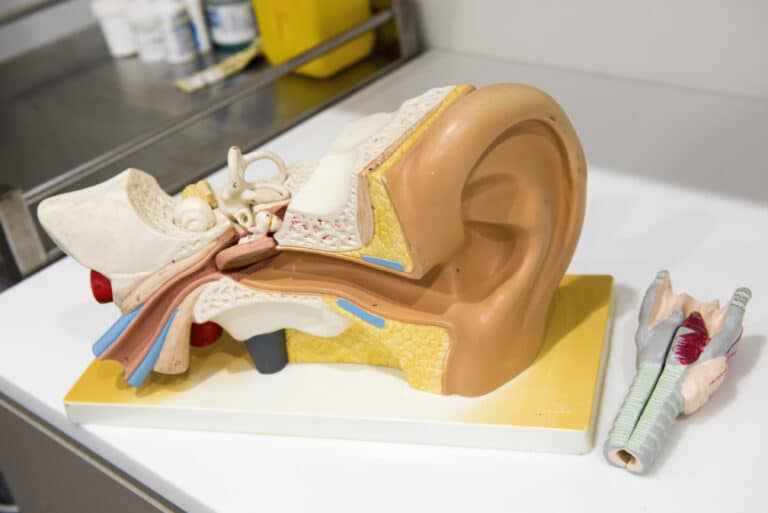Ear Infections
Ear infections are very common. They are more common in summer than they are in the winter months. Causes include placing a foreign body such as a cotton bud into the ear. An ear infection can also result from fluid being introduced into the ear due to swimming in infected waters and pools. Ear infections can come on quite suddenly and can be a very painful condition. If normal medications such as oral antibiotics and topical drops don’t relieve conditions, the ear will need to be seen to quite quickly.
An ear infection type falls into three different categories; there can be a viral infection which is very unusual and almost always has vesicles and is associated with conditions such as herpes and shingles. Bacterial infection which is the most common and is the most painful with the swelling of the outer canal and sometimes the external ear. It often has a throbbing sensation and is much worse when the outer ear is moved. The third type of infection is a fungal infection. This fungal infection or thrush is likely to follow a bacterial infection that has been treated with topical or oral antibiotics. Just as in any other complaints in the body when treated with antibiotics the good and bad bacteria are killed at the same time and this allows the opportunity for fungal infections to take hold. The fungal infections are quite insidious in that they continue to occur every 4 to 5 weeks, almost indefinitely if not treated correctly. The fungal infection is less painful than the bacterial infection, but is very itchy, blocks the ear canal and has a large amount of discharge associated with it.
The role of the ENT Surgeon in ear infections is to toilet the ear. This involves suctioning the ear out, cleaning any debris and allowing the normal bacteria to return. This is very different from having the ear syringed, where water debris and further infection are pushed around into the entire ear canal. An ear toilet is suctioning of the ear under inspection by the ENT Surgeon. This gives a better evaluation of the ear health, both the external and the tympanic membrane. It also allows infectious material to be removed from the ear and returning hearing to normal more quickly. If this material is not removed, the infection may resolve for a period of time, but tends to reoccur with water contact.
The most important thing with ear infections is to keep the area completely dry. Any fluid introduced to the ear whilst the infective process is occurring will only worsen the condition.

ABC Rural
Story of Cockroach Crawling into Camper's Ear Prompts Outpouring of Similar Tales on Social Media
Maroochydore-based ear, nose and throat specialist Adam Blond said insects entering ears were more common than people thought. He said he treated at least one case every couple of weeks and the rate increased during warm holiday seasons when people camp with lights outside.
“Small cockroaches are really common, occasionally spiders, but more likely mozzies and moths get caught in there,” Dr Blond said.
Hearing Loss Assessment
The most common cause of long term hearing loss is wax build up in the ear. This accounts for about 80% of all long term slow hearing loss. There are many other forms of hearing loss, noise exposure, congenital and family history, but there are some forms of sudden loss that are quite sever and disabling. These need urgent attention.
Hearing falls into three different categories; there is conductive hearing where the sound is being transmitted from the outer ear through the external auditory canal, through the tympanic membrane and the ossicles, to the small bones in the middle ear. The sound moving through this area is considered to be conductive hearing. The cochlea then senses and converts this hearing into electrical impulses called the sensory hearing. The neural component is the neural pathway from the cochlear and the brain itself.
Sensorineural Hearing Loss
A sudden onset of a sensorineural hearing loss is a severe emergency and needs to be seen within a very short period of time. Often the patient will need to be treated with high dose steroids and sometimes antiviral medication depending upon their condition.
Most hearing losses can be differentiated between conductive hearing which is most likely wax, infection and debris in the external canal from the sensorineural type which is actually a nerve or sensory loss. Occasionally a hearing assessment is required to differentiate between these.
Often ENT Specialists are seen to give an unbiased opinion about hearing aids. Hearing aids themselves can be quite expensive and in some cases may be suggested where the patient does not necessarily need the aid. A formal assessment of hearing loss with a full diagnostic audiological assessment is often beneficial before seeing the ENT Surgeon. Then a full discussion can cover all the areas of hearing loss and the patient’s needs.
Oral Toilet
Oral toilet is a name of suctioning of the ears. This suctioning is done under vision using a microscope. This gives the ENT Surgeon the opportunity to examine the health of the outer and middle ear whilst cleaning the ears of debris. This is sometimes required for a regular wax build up, infections or post surgical care.
Grommets
The insertion of grommets is one of the most common procedures performed on paediatric patients worldwide. This involves placing a small aeration tube in the tympanic membrane. This tube grows across the tympanic membrane with the skin that normally migrates to the outer surface of the tympanic membrane. The grommet falls out on its own after a given period of time. While the grommet is in, it allows the Eustachian tube, the tube used by an adult to pop their ears, to be bypassed. This stops ears infections and also makes the hearing normal whilst the grommet is in place. This is done for recurrent middle ear infections and conductive hearing loss which is often associated with speech delay.
Specialist Ear Surgery
A number of conditions of the outer ear and middle ear often require surgical intervention by an ENT Specialist. These can be the following;
Myringoplasty, the correction of a perforation or hole in the outer drum. This causes infections with water exposure over and over again. The operation is performed to make the ear dry and safe and also in the hope of improving hearing in large perforations.
Exostoses, which is bony outer growth or surfer’s ear. This involves the lay down of bone in the outer canal over many years. This is very common in people with cold water contact, not necessarily surfers. This requires an operation to drill out the ear and remove this bone allowing the normal migration of skin and wax through the outer ear and also to stop further infections and improve hearing.
Cholesteatoma, which is a tumour of the middle ear. This is a benign tumour where there is an overgrowth of skin from the tympanic membrane that migrates into the middle ear and can erode bones, the small ossicles in the middle ear. This can cause erosion into the skull or brain and also destruction of the balance and hearing part of the middle ear. This often requires surgical intervention to remove this lesion.
Stapedectomy is a surgical procedure in a condition called otosclerosis. This is a congenital condition where the foot plate or stapes becomes fixed to the oval window of the cochlea. This stops the transmission or conduction of sound through to the cochlea. A stapedectomy is a procedure in which the stapes is removed and a small piston is placed from the incus, one of the ossicles in the middle ear, into the cochlea itself.
